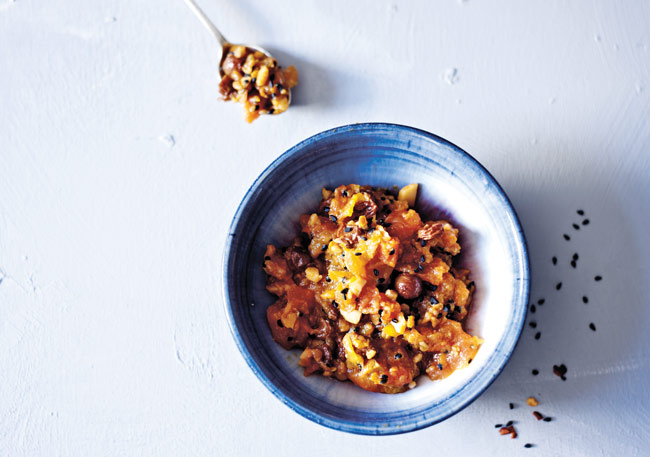Indian tomato and nigella seed chutney
Put your tomato glut to good use with this Indian chutney recipe

This spicy Indian chutney recipe from Emily MacDonald of The Bay Tree is delicious served with roast lamb
Makes 950g
- Tomatoes 2kg
- Distilled white vinegar 600ml
- Granulated sugar 1kg
- Garlic 8 cloves, crushed
- Nigella seeds 4 tsp
- Raisins 100g
- Blanched almonds 50g, chopped
- Dried chilli flakes 1 tsp
- Bay leaves 3
- Salt 1 tsp
- With a sharp knife, cut a cross in the skin of each tomato, then put in a heatproof bowl and cover with boiling water. Leave to stand for 2–3 minutes, then drain. Peel off and discard the skins. Roughly chop the flesh.
- Put the tomatoes, vinegar and 300ml of water in a preserving pan. Add all the remaining ingredients, stir together and slowly bring to the boil.
- Reduce the heat and simmer for about 1½ hours until no excess liquid remains. Stir from time to time to prevent the mixture from sticking to the bottom of the pan. Remove and discard the bay leaves.
- Meanwhile, sterilize enough jars with non-metallic, vinegar-proof lids, or preserving jars, so that they are ready to use.
- Spoon the chutney into the warmed, sterilized jars. Seal immediately and label. The chutney can be eaten immediately and doesn’t need to mature. Refrigerate after opening.
The Bay Tree Preserving by Emma MacDonald is published by Nourish Books.
Supported by
You will need
- Tomatoes 2kg
- Distilled white vinegar 600ml
- Granulated sugar 1kg
- Garlic 8 cloves, crushed
- Nigella seeds 4 tsp
- Raisins 100g
- Blanched almonds 50g, chopped
- Dried chilli flakes 1 tsp
- Bay leaves 3
- Salt 1 tsp
Method
- With a sharp knife, cut a cross in the skin of each tomato, then put in a heatproof bowl and cover with boiling water. Leave to stand for 2–3 minutes, then drain. Peel off and discard the skins. Roughly chop the flesh.
- Put the tomatoes, vinegar and 300ml of water in a preserving pan. Add all the remaining ingredients, stir together and slowly bring to the boil.
- Reduce the heat and simmer for about 1½ hours until no excess liquid remains. Stir from time to time to prevent the mixture from sticking to the bottom of the pan. Remove and discard the bay leaves.
- Meanwhile, sterilize enough jars with non-metallic, vinegar-proof lids, or preserving jars, so that they are ready to use.
- Spoon the chutney into the warmed, sterilized jars. Seal immediately and label. The chutney can be eaten immediately and doesn’t need to mature. Refrigerate after opening.
The Bay Tree Preserving by Emma MacDonald is published by Nourish Books.
You may also like
